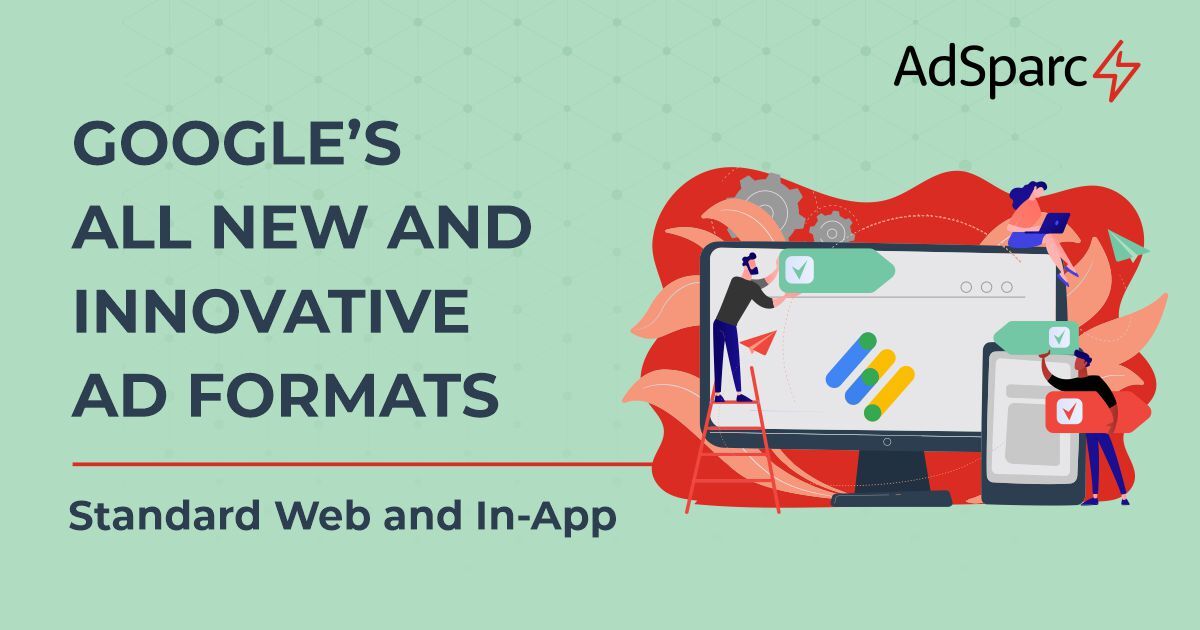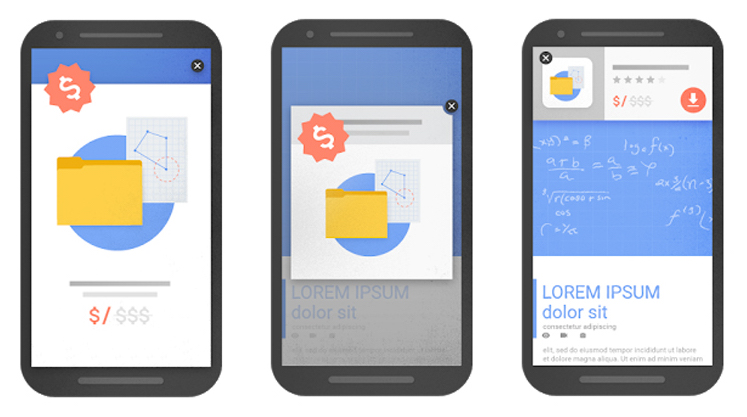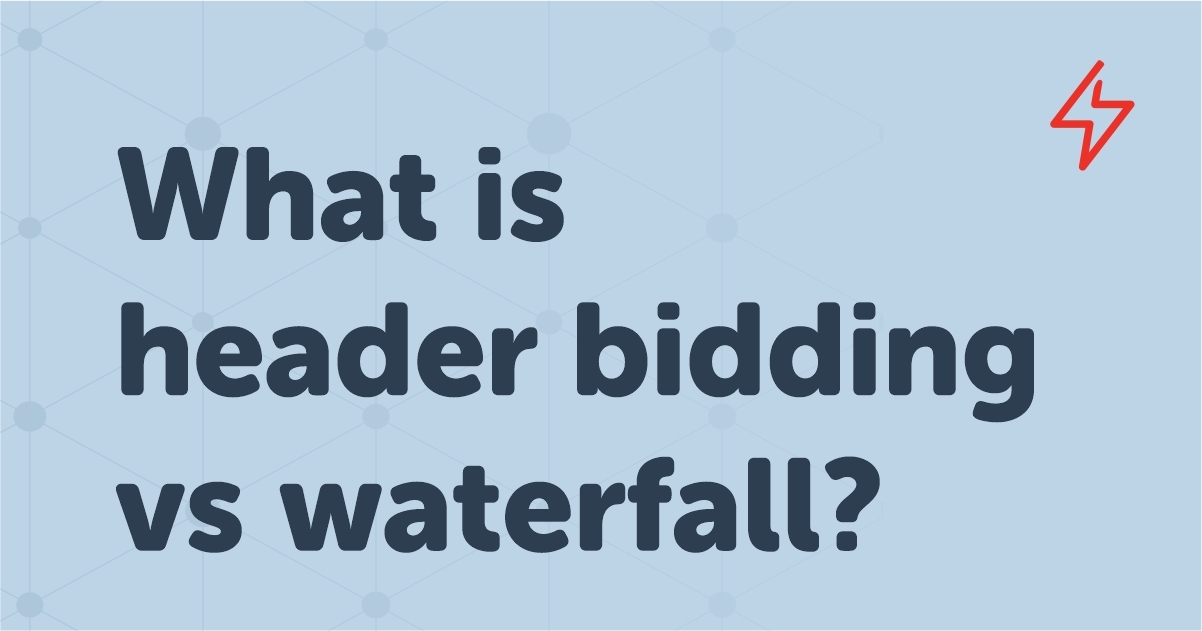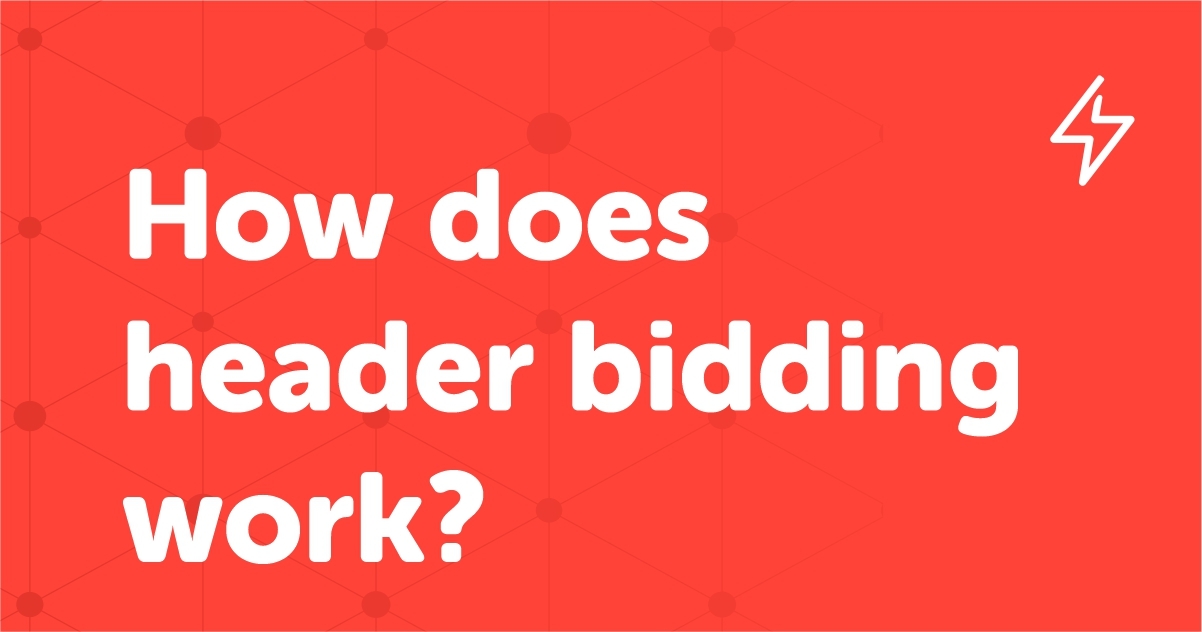Table of Contents

Google recently dropped new innovative ad formats for publishers. But, are you struggling to find the best use case of each of those new ad formats? Questions like, what is an interstitial ad, what are AdSense anchor ads, interstitial ad examples, or a sticky ads amp, are constantly revolving in your brain? Then you have landed on a handy, informative blog related to the new Innovative Ad Formats from Google. The journey of Google experimenting in the ad space to help out the publisher can be dated back to the 2000s. From the banner era of 1994 to new innovative Ad Formats 2021 from Google, the aspect of viewability, visibility, revenue and spend reports for the publisher has evolved completely!
Gone are those days with standard ad formats for everyone. Now, as a publisher, you can amp up your revenue as per your preference and requirements. Currently, ad formats are all about better visibility, viewability, placement, and more. When it comes to new innovative Google ad formats, each ad format has its own benefits. Whether the ease and affordability of running a text ad or the colorful storytelling that comes with a video or quick-hit information, image ads, app, or digital content ads, you can have it all under one roof!
You can run multiple kinds of ads from the same Google Ads account and, in some cases, from the same campaign. Many campaigns benefit from using a variety of ad formats. Not sure which ones to use? Read on. We provide an overview of all the Google Ad formats you have at your disposal.
Let’s jump into the basics and start with the new innovative ad formats from Google, their benefits, and how to get started?
Content Table:
A. Desktop and Mobile Web Ads 1. Web Interstitial 2. Anchor Ads 3. Multiplex Ads B. In-App Ads 4. Rewarded Interstitial Ads 5. App Open Ads
|
The new Innovative Ad Formats from Google
Desktop and Mobile Web Ads
1. Web Interstitial
Interstitial web Ads have gained popularity over the years and became accepted as a format on mobile and traditional web experiences. With the dawn of innovation in ad formats via video, native, and mobile advertising, pop-up Ads have evolved into Interstitial ads, the transition took place around late 2020. Web or Interstitial Mobile Ads are usually full-screen ads covering most of the active screen, they can float over a web page in view or fill the screen on a mobile device. Interstitial Ads appear in between the content a user is engaging with. It is triggered by clicking a link within the article, serves interstitial with a clear exit option, and is directed to the following page. The critical difference between a Pop-up Ad and a Web Interstitial Ad is that Pop-up Ads can appear at any time, defying the user experience. In contrast, Web Interstitials only appear between two web pages without hampering the user experience.
What does it look like?

Image Source: Google
What Are the Benefits of Web Interstitial Ads?
- It has the potential to deliver higher click-through rates, more ad impressions, higher conversion rates, and amplified revenue
- It deals with a larger format size that encourages greater creativity and improved user engagement
- The revenue opportunity is the main reason sites may use or at least test Interstitial Ads
- Web interstitials were designed with the user in mind
- It provides a clear option for the user to navigate away from the ad, continuing with the content
How to get started?
- Tagging
-Add the INTERSTITIAL GPT slot type to the <head> element of the web page
-Display the ad slot as you would any other ad slot
-See more tagging details, including how to prevent certain links from triggering the interstitial, in the developer documentation
- Trafficking
Create ad units (or use existing ones) for interstitial slots. To streamline trafficking, include the sizes 320×480, 300×250, and 336×280
- Create line items:
-For reserved inventory: Target inventory as normal. Creatives must have the size 320×480, 300×250, or 336×280. Note that you can target line items by Inventory format, with “Interstitial” as an option
-For non-reserved inventory: Include the relevant ad unit in the Ad Exchange line item. Include the sizes 320×480, 300×250, or 336×280 in the associated placeholder creative. These fixed sizes are needed only for trafficking purposes on Ad Exchange line items. Ads served programmatically can be a range of sizes depending on the size of the viewport
- Reporting
Use the “Inventory format” dimension to see how interstitials perform compared to other formats
- Demo interstitials
To demo the interstitial format, append #gamInterstitialDemo to a website page that already has some GPT tags. Clicking a navigation link on the page should trigger the format
2. Anchor Ads or sticky ads
Google’s latest announcement with Anchor Ads cheered up publishers across the platform. Anchor ads, a.k.a. sticky ads are now available in Open Beta via GAM360. Earlier, publishers could use anchor ads but with some stipulations. They had to personally build the sticky functionality, ensure its compatibility, and manage the whole ad process themselves; it also created a sense of discomfort amongst the publishers. Now, with the latest improvements, publishers can easily implement mobile sticky ads without any risk, compliance issues, or extra approval steps.
What is an Anchor Ad exactly?
If a user scrolls down a website and notices an ad stuck to the top (header) or bottom (footer) of the screen, then a user has encountered an anchor ad. Simply put, anchor ads stick to the viewport during a user’s session or interaction, regardless of how far down a page they scroll.
What does it look like?
Image Source: Google
What Are the Benefits of Anchor Ads?
- Higher Viewability: Sticky ads or Anchor ads have a 100% viewability rate. The reason behind it is that users see them for a more extended period, more likely to click it, increasing the revenue and, in turn, advertisers’ willingness to pay a premium for the placements
- Increased Monetisation: It allows publishers to increase per-page ad density and maximize backfill demand, increasing auction pressure
- Improved Targeting: Publishers can target Line items, set pricing rules via specific ad units, and set orders with higher CPMs and CPCs
- Unified Reporting: Google added a new reporting dimension that allows publishers to use the Inventory Format dimension in Historical Reporting
How to get started?
- Tagging: Add a new GPT tag in your mobile pages’ <head> element with ad slot type TOP_ANCHOR or BOTTOM_ANCHOR.
- Trafficking: Create new ad units (or reuse existing ones) for anchor slots with 320×50 included. Next, create new line items (or reuse existing ones) targeting the anchor slots. Anchor ads support both reservations and backfill. Note that you can target line items by Inventory format, with “Anchor” as an option.
- Reporting: Use the “Inventory format” dimension to see how anchor ads perform compared to other formats.
Note: Anchor Ads use a similar implementation process as Web Interstitials. Save time by editing your GPT simultaneously.
3. Multiplex Ads
Multiplex ads have been envisaged as an alternative to content recommendation solutions. However, multiplex ads took a distinctive approach. Rather than encouraging a separate pool of content-recommendation demand, it acts as a native format from Google that ties into their core advertising demand from Google Ads and partners. Multiplex may look like a content recommendation, but it isn’t.
In simple words, they are grids of native ads that maximise both revenue and user experience. They are a brand-safe replacement for content recommendation ads. They are served via Google Ad Manager, much like other native ads. They allow a group of ads to be served in a block that can be styled to match the publisher site. Multiplex ads are compatible on desktop, mobile and tablet as well.
What does it look like?
Image Source: Google
What are the benefits of Multiplex ads?
Google Multiplex Ads are a newbie format. However, they do promise some benefit over the content-recommendation ads that they are competing for space with:
- Quality advertisers without the clickbait, as Google ads are strictly regulated it reduces the risk of low ad quality
- No restraining contracts
- Consistent payments
- Manage alongside other Google demand via GAM
- Continually self-optimizing
- No blank impressions problem as Google deals with the largest pool of ad buyers
- Leveraging a new ad format like this is always an excellent way to tackle banner blindness
How to get started?
Currently, it is an invite-only solution, i.e., publishers personally cannot run these ads. They can work with a Google Certified Publishing Partner (GCPP) who has access to the beta (like AdSparc). Once publishers get access to run multiplex ads on their website, the process is similar to the native ads setup under GAM:
- Sign in to your GAM account
- Click on Delivery > Native > New Native Ad > and select Multiplex ad
- Either you can go for the ‘Let Google Optimise layout’ option or select a layout option on your own
- If you go ahead and customize the layout options, deactivate the ‘Let Google Optimise layout’ and select the layout, number of columns, and rows you want for the ads
- You can further customize the fonts and colors
- Click on Continue and then move to target
- Targeting should match the line item’s targeting; otherwise, you won’t be able to serve Multiplex ads
- You can also select the geographical location, device category, and custom targeting
- Save and activate. Now your website is ready for displaying Multiplex ads
B. Now, let’s talk about the In-App Ads
4. Rewarded Interstitial Ads
Rewarded interstitial is a new format that helps deliver more impressions by offering meaningful in-app rewards for watching full-page interstitial ads. The new advertising format aims to help developers increase in-app engagement by showing rewarded ads while they play games. A new type of incentivised ad format allows you to offer rewards, such as coins or extra lives, for ads that appear automatically during natural app transitions. According to beta testing by Ilyon Games, the new format boosted growth in eCPM by 3x, while revenues shot up 2.5x and ARPDAU increased 80%.
Currently, only skippable ads will be served in rewarded interstitial ad units. This includes demand from AdMob and Facebook Audience Network. Mediation with other ad sources is not currently supported but may be added in the future.
How do rewarded interstitial ads work?
Rewarded interstitial ads can serve without requiring the user to opt-in to viewing. During the experience, the user can decide to skip the ad or stop viewing the ad.
You can specify the reward values associated with the ad units in your app and set different rewards for different ad units. Users will receive the reward for interacting with the ad without needing to install anything.
What does it look like?
Before displaying a rewarded interstitial ad to users, you must present the user with an introduction screen that includes the following:
- Clear reward messaging that incentivizes users to view the ad
- A clear, unobstructed option to skip the ad before it starts
- Sufficient time for the user to understand the reward and opt-out if they don’t want to view the ad
Image Source: Google
For Example:
A user playing a game has just completed a level; before the next level starts, the user is prompted that an ad will begin in a few seconds and the reward for watching the ad is an extra heart or an energy booster. The user has the option to close the ad or go with it! After a few seconds, the ad begins with a countdown that lets users know how much time is left until they receive the reward. If the user clicks to exit the ad, a prompt appears to warn about the loss of the reward. The user must confirm that they want to exit the ad before the ad closes.
What are the benefits of rewarded interstitial ads?
- Unlock new placements with just-in-time and contextually relevant rewards
- Replace low opt-in rewarded placements to boost impressions volume leading to revenue uplift
- Better UX Offer superior user experience with minimal impact on retention
How to get started?
Android: The main steps to integrate rewarded interstitial ads are
- Load an ad
Loading an ad is accomplished using the static method on the Rewarded Interstitial Ad class. The load method requires a Context, your ad unit ID, an object, and a rewarded interstitial ad load callback to be notified when ad loading succeeds or fails. The loaded object is provided as a parameter in the callback
- Register for full-screen event callbacks
In order to receive notifications for presentation events, you must pass a Fullscreen content callback object to the setter on your ad. The object handles callbacks for when the ad presents successfully or unsuccessfully, and when it is dismissed
- Handle the reward call back
To display your rewarded interstitial ad, implement the interface in your Main Activity, to be notified when the user earns a reward
- Display the ad
After implementing the interface, you can present the ad using the ad’s show method
IOS: The main steps to integrate rewarded interstitial ads are
- Load an ad
Loading an ad is accomplished using the static load method. The load method requires your ad unit ID, a DFP Request object, and a completion handler which gets called when ad loading succeeds or fails. The loaded object is provided as a parameter in the completion handler
- Register for callbacks
In order to receive notifications for presentation events, you must implement the protocol and assign it to the property of the returned ad. The protocol handles callbacks for when the ad presents successfully or unsuccessfully, and when it is dismissed
- Display the ad and handle the reward event
When presenting your ad, you must provide a GADUserDidEarnRewardHandler object to handle the reward for the user
5. App Open Ads
App open ad is currently in a beta release on Google. App open ads help to monetize your mobile app loading experience. App open ads are the new ad type catered to the user when he/she minimizes the app and returns. An ad format that appears when users open or switches back to the app. Ad overlays the loading screen.
What does it look like?
Image Source: Google
What are the benefits of App Open Ads?
- Experience strong performance and unlock new inventory
- Highest bidding ad creatives with flexible format with full screen and partial screen ads
- Great ad creatives for each user’s device dimensions and witness best user experience-optimized rendering
- Refined user experience comprises optimized branding for your brand (15% of the screen). That automatically includes app icon, app name, and transparent background overlaying your app content
- Simple and easy implementation. Just request an app open ad, and AdMob/GAM will take care of the rest. No format maintenance
- Continuous user testing and UX optimization and optimisation for latency
How to get started?
- Sign in to your AdMob acct at https://apps.admob.com or GAM acct at https://admanager.google.com/
- Click Apps in the sidebar
- Select the name of the app you’re creating this ad unit for
- Click Ad units in the sidebar
- Click Add ad unit
- To create line items eligible for app open, follow the general directions on how to create a line item, making the following selections along the way:
- Sizes: Line items need to be 320×480 (Mobile Portrait Full Screen) and/or 480×320 (Mobile Landscape Full Screen) for phones. For tablets, line items need to be 1024×768 (Tablet Landscape Full Screen) and/or 768×1024 (Tablet Portrait Full Screen)
- Click Select for the App open ad format
- Implement the format using the documentation for AdMob (Android I iOS) or GAM (iOS I Android)
- Share feedback as you implement and test
Why are these new ad formats the next big thing for better revenues?
We have listed, rather ensembled, a definitive answer towards “Why to use new Google Ad formats?” and “Why are these new innovative ad formats the next big thing for better revenues?” by now. Google has something for businesses of all sizes with various budgets and unique advertising goals. A plethora of multiple target audiences — most of them have used Google at least once in their life to find the answer to a problem. The line to be inserted: Google has been looking at multiple new technologies that permit targeted advertising while protecting users’ privacy. Currently, the Federated Learning of Cohorts (FloC) or Google FLoC is creating a buzz. So, in an infinite thread of seemingly endless searches that includes more than 2+ trillion searches per year — why wouldn’t you pull some threads to see how much revenue you could churn up?
Competition is rising, and the clock is ticking on your revenues. Start experimenting with various ad formats and see what acts as a game-changer for you. To become a master in something, you need an expert’s guidance to reach mastery. Sign up with AdSparc and experience unique -highly viewable- ad units with AdSparc’s AdSuite. Start catapulting the organic search results and earn clicks and conversions with the help of Google Ads and a delightful post-click landing page experience.
What’s Good About AdSuite?
-
Incremental Revenue:
Utilise unused ad positions: Publishers who use AdSuite ad units have seen revenues increase substantially by utilizing new ad positions. Because of the high viewability rates, the ads attract high CPMs and high fill rates.
-
Excellent User Experience:
Non-intrusive ad formats: The ad slides in smoothly at the top of the page and does not use pop-ups or pop-under. It will easily fit in on most sites.
-
Easy Implementation with One Tag:
No need for site redesign: Adding new formats can be a pain that requires the site to be redesigned. This is not needed for AdSuite ad units. AdSuite now can be implemented with a single tag for multiple ad units. No need for multiple tags for different ad units.
-
Power of Prebid Demand:
Maximise yield with bids from multiple SSPs: AdSuite is powered by Prebid demand with 10-15 SSPs, bringing an additional level of competition to AdX. This results in maximum yield for AdSuite ad units.
-
Standard Formats:
High fills because of multiple format support: All standard formats are supported: 970×250, 970×90, 728×90, 300×250, 300×600, 120×600, 160×600, 468×60, ensuring maximal fill rates.
Sign up for an AdSuite demo today!
Also Read: The Ultimate Guide to Core Web Vitals for Publishers







